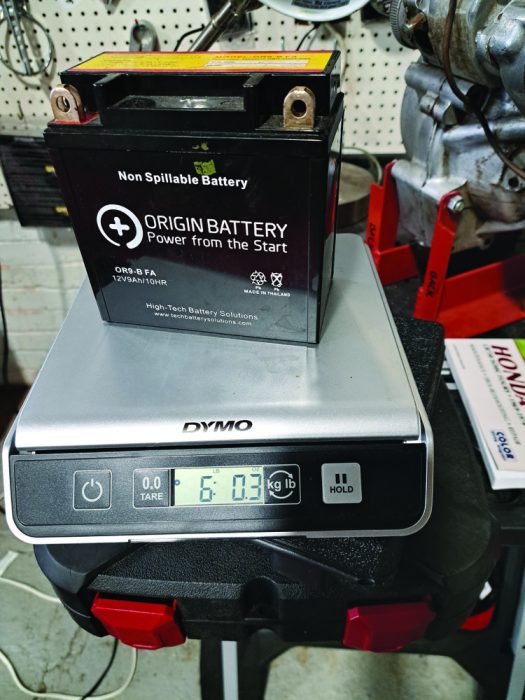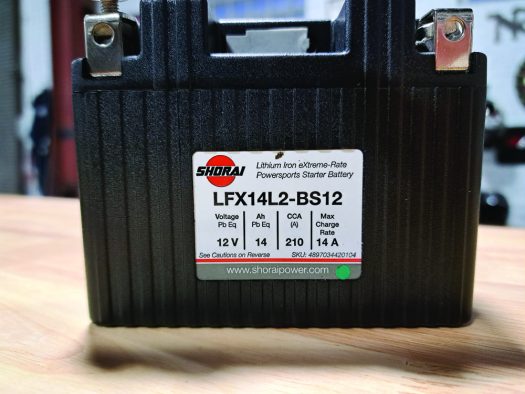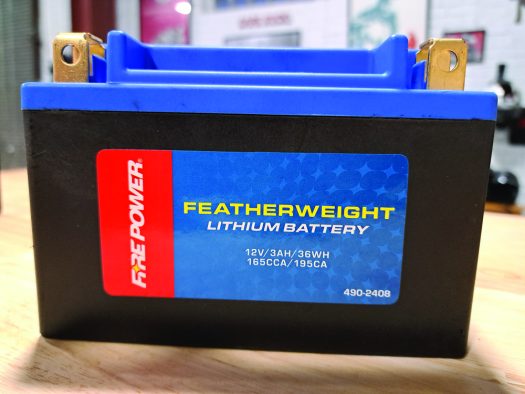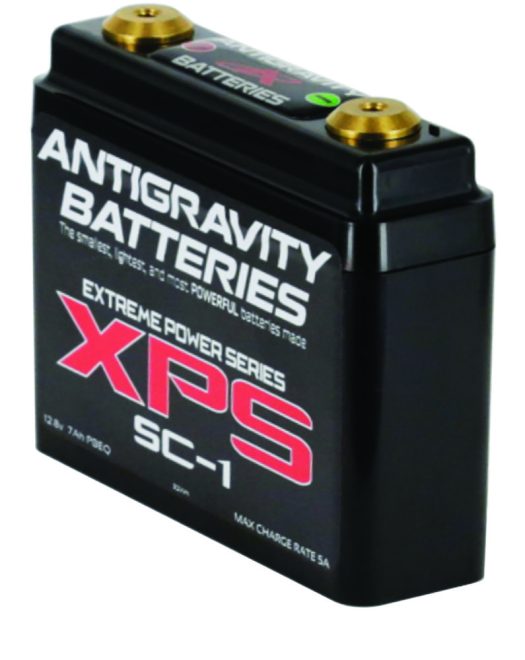
CHARGE OF THE LIGHT BRIGADE
Differentiating different batteries: A traditional AGM or sealed lead acid battery (1) is larger and far heavier than a Firepower lithium cell battery (2), which is equipped with a built-in LED test light, and the tiny Shorai lithium battery (3).




The compact
dimensions and
incredible cold cranking
amps of Antigravity’s four-cell lithium
batteries make them popular with
custom cafe racer builders.
Story and Photos by Mike Seate
We’ve experienced a love-loathe relationship with lithium batteries over the past 17 years, having installed several of the featherweight power cells in project bikes to varying degrees of success. Read our custom motorcycles features and you’ll find bike designers who swear by the tiny, low-maintenance batteries and an equal number of builders who avoid them outright. Why the division over an aftermarket accessory that reduces a motorcycle’s weight and maintenance time? We put this question to veteran Honda motorcycle technician Bob Hesch who wasted no words explaining his aversion to lithium batteries, saying “if they’re so good, why haven’t any OEMs included lithium ion batteries in their production bikes? Worse yet, I’ve heard too many instances of them catching fire or just crapping out suddenly,” said the former WERA roadracing champ.
Bob was referring to issues with the high price longevity of these 21st Century marvels, which runs two to three times the cost of lead acid batteries. This price point also explains why motorcycle manufacturers don’t include lithium cells as standard -— they’re just too pricey.
The dangers of using this new technology have been largely overstated, though connecting a lithium battery to a traditional charger that’s not equipped with an automatic overcharge shut-off switch can result in fires.
As for their reputed brief shelf life, lithium batteries do indeed, have a composition that lends them a decidedly finite service period. Unlike traditional lead acid or AGM, (or absorbed fiberglass mat, often called gel batteries) lithium batteries can not be recharged after a number of the individual cells have been over-discharged.
Some, like the popular Shorai brand batteries, require regular recharging, explained company tech Tom Schumacher. “Once a Shorai has been over-discharged, you can re-attach the special charging unit and it may come back up to full charge of around 13.4 volts. If the battery was purchased within a certain date, we will replace a permanently discharged unit under warranty, but it’s important to re-charge them if the motorcycle is sitting unused for a few weeks or months,” he explained.
True to form, a Shorai unit installed in our 1967 Triton has sat idle for the better part of a year and was reading just 7.9 volts when checked with a voltmeter. After attached to the special Shorai charger (around $50) it did recover to a fully-operational 13.4 volts in a couple of hours. Schumacher noted that traditional trickle chargers can work with Shorai batteries, but their bespoke charger is needed to access the special store mode and other features unique to the brand.
Though our other veteran tech Nick Coumos also prefers old school lead acid batteries to lithium, he was rather impressed by the fact that the tiny, 5” wide Shorai battery packs enough power — or cold cranking amps — to turn over the Triton’s 750cc Triumph Bonneville engine. We had planned on using an Origin brand lead acid cell for a T140 Triumph ($89.99) that weighs a beefy 5.3 pounds to crank over the Triton, but it’s too tall and wide to nestle within the cramped confines of a Norton battery box. Meanwhile the $160 Shorai weighs just 1.5 pounds and is small enough to leave room within the battery box for several other electrical components.
We compared the cold cranking amps of the Shorai to those of another popular lithium cell from Firepower. Though considerably larger, the Firepower cell ($129.99) offered 165 cold cranking amps (the power needed to turn over an engine from cold) which is actually below that of the Shoira which comes in at 210 CCA. However, the Firepower battery benefits from a shelf life of 12 months before requiring recharging and its sealed design means it can be mounted in any position. This, along with a set of included plastic mounting blocks and a built-in LED test meter, makes the Firepower excellent for custom applications.
Another popular lithium option are the impossibly small batteries available from Antigravity. Their compact design creates batteries so small, they’re mainly recommended for racing and competition-only applications, though the company does produce larger units that are fitted with something called restart technology making them more durable than their smallest cells. Many custom cafe racer builders swear by the 16 ounce, cigarette-pack sized Antigravity batteries which are easily concealed beneath seat humps or under fuel tanks, but their prohibitive retail prices (upwards of $200-$300) makes the less practical than many others. A special charger is also required for most applications, but with cold cranking rates of up to 300 (or 30% more than lead acid cells) these puppies can crank over even a high-compression V-twin in seconds. It’s worth noting that all lithium-based batteries are negatively affected by cold weather. This explains why we’ve had to frequently recharge those stored in the poorly-heated CRM garage. To avoid this, some web forums have suggested removing them during long winter layoffs and storing lithium batteries in a warm, dry space such as a basement or heated interior room of the house. It’s all about how much you’re willing to spend when investing in new battery tech and how important shedding a few extra pounds is to you and your ride.
Batteries at a Glance
The ever-expanding offerings in the motorcycle battery market may seem confusing at first glance, but each type of power cell offers its own particular advantages and foibles, so choose wisely. Like motorcycles, battery prices vary wildly as do the exterior dimensions from brand to brand and between makes and models. Here are a few of the most common battery types available. Do your homework and charge on!
Lead Acid – Traditional units that are characterized by large dimensions, lengthy service lives and a time-consuming need to be replenished with distilled water, especially during warm weather. Prone to leaking corrosive battery acid if not maintained properly, lead acid batteries are affordable, but increasingly considered out-of-date by modern standards.
AGM – An acronym for a traditional cell that’s filled with acid and built with individual lead plates that are fed by a fiberglass mat. Maintenance-free and permanently sealed, AGM batteries are favored by most OEMs and can last for several years. Heavy by lithium battery standards, they’re robust and can crank over the heaviest, accessory-laden motorcycles with ease.
Lithium Ion Phosphate – Considered superior for their high charging rate, these are comparable to the best AGM cells and last for years. Basically filled with lithium ion phosphate – or LIFePO4- that acts as a positive electrode and a carbon-based material working as the negative, LIP batteries are small, light and costlier than an AGM or lead acid battery.